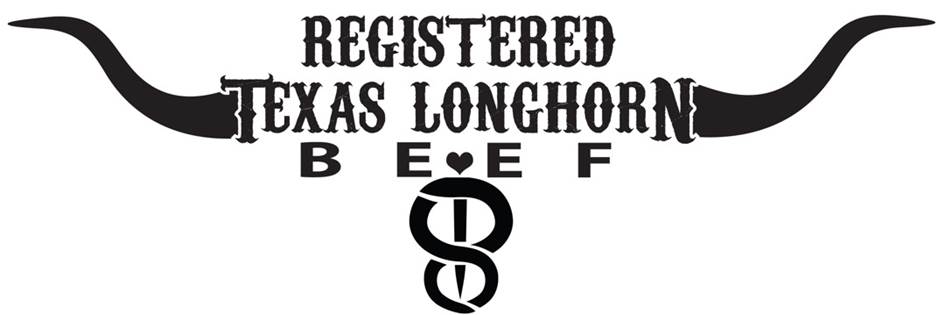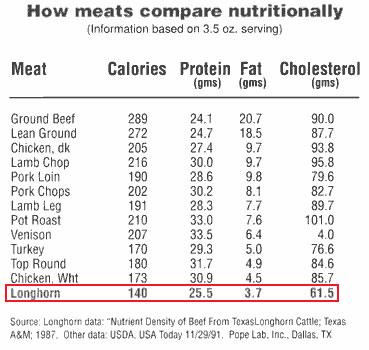
Currently Cactus Rose Longhorns does not sell beef by the pound. We do offer whole, half and quarter packages at this time when they are available. Call 361-781-4221 for availability or waiting list information.
About Our Registered Texas Longhorn Beef
We raise Registered Texas Longhorn cattle, icons of Western culture, simply because we find them beautiful. Sale of grassfed Longhorn beef is truly secondary to growing our herd and producing gorgeous animals that epitomize this unique breed. Through thoughtful breeding, the animals in our small herd exhibit classic breed attributes such as climate adaptability, disease and parasite resistance, and trim physiques with less muscle marbling.
What does all that mean to you, the beef consumer?
Because we are raising a small number of animals to exemplify the Texas Longhorn breed, we have no need or desire to ever supplement their feed with hormones or antibiotics to produce a “fat” cow. We love to see our naturally trim cattle grazing on pasture that we fertilize with an organic kelp derived fertilizer. We are not a crowded commercial beef operation, and our herd has room to roam and soak up the Texas sunshine. When the herd size needs to be reduced, we use that as an opportunity to offer up grassfed and finished, organic, hormone free, antibiotic free, humanely raised beef to nourish our family as well as yours.
Nutritional Information
Unfamiliar with the health benefits of eating grassfed beef? Visit The World's Healthiest Foods website to learn more.

How to Know our Registered Longhorn Beef is Grassfed without Reading the Label
-
The small amount fat you can see will be more yellow than white. Grainfed beef will usually have a thick layer of white fat.
-
There will be little marbling visible.
-
The taste will be noticeably richer and “beefier.” We like to say it just tastes better!
-
The meat will usually have a firmer texture when cooked.
Cooking with Registered Texas Longhorn Beef
-
Texas Longhorn beef cooks quickly due to its low fat content. Fat acts as an insulator. Heat must penetrate the fat before it begins to cook the meat. Lower fat means a faster cook time.
-
Longhorn beef does not require additional fat for cooking. The natural fat is enough to cook your meat to perfection. However, you can certainly add a healthy cooking fat of your choice like tallow, grass fed butter, coconut or olive oil.
-
There is little shrinkage in Longhorn beef.
-
To broil, position the meat 3-4 inches from the heat. Watch it closely while cooking to achieve desired doneness. Broiling slightly frozen steaks keeps them juicier.
-
A medium-hot fire works best in grilling. Add damp mesquite or cherry wood chips to the fire for extra flavor. Remember, the meat cooks quickly so watch it carefully.
-
Longhorn beef roasts should be cooked at 275 degrees F. A meat thermometer is recommended to monitor desired doneness.
-
Ground beef should have an internal temperature of 160 degrees F.
-
For steaks, salt your meat ahead of time with kosher salt up to a day or two in advance but a minimum of 30 minutes. Salting early seasons the beef all the way through and it’ll be more moist and tender.
Notes on Buying Meat Directly from the Producer
We’re all so used to buying meat from the grocery store that is precut, wrapped in plastic and neatly labeled for us that buying a whole or half animal can come with a learning curve. Here are some terms you will need to know when purchasing on the hoof or whole/half carcasses:
-
Live Weight: The weight of the entire living animal.
-
Hanging Weight: Sometimes referred to as the hot carcass weight, this number is taken after the slaughter but before trimming begins. This weight includes the bones and organs.
-
Final Weight: Sometimes referred to as the take home weight, this number represents the total pounds of usable cuts after trimming.
When buying whole or half animals, we strongly recommend you consider selecting bone-in cuts to get the most for your money (and bone-in cuts are delicious!). Bones can be purchased separately for making broths and stocks, or even dog treats. The same can be said for organ meats and cuts like oxtail or tongue. Consuming as much of the animal as possible is not only respectful to the animal that is nourishing you but nutritious and economical!
Visit the Texas Longhorn Breeders Association of America website for more information on Registered Texas Longhorn Beef.